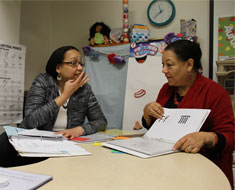Factor 1- Direct and daily access to language and communication is essential to facilitating each child's language and communication development.
|
To guide our team in identifying evidence shown to support linguistic competence, we followed definitions of evidence described in Evidence-Based Practice in the Early Childhood Field (Buysse & Wesley, 2006). In this book, specific to the field of early childhood, evidence includes: 1) "the best available research" (based on research studies, evaluations, objective measurements of child progress, and systematic literature reviews), 2) practitioner experience or professional and/or family wisdom (based on personal observation, experience, professional or expert consensus, position papers, policy statements, and professional judgment), and 3) consumers' values and beliefs, which include personal beliefs, concerns, and expectations of consumers (parents and professionals). |
Factor 1 Evidence Summary

The evidence supporting Factor 1 centers on the importance of language access occurring early in a child's life and the critical nature of quality parent-child communication in the establishment of linguistic competence.
Research from children with typical hearing indicates that interactions between parents and their children during the early years of life builds critically important foundations in language, cognition, and literacy, and that compensating for the lack of early exposure to varied and abundant parent-child interactions during the first three years of life is nearly impossible (Hart & Risley, 1995). Evidence with children who are deaf or hard of hearing indicates that maternal communication skills/family involvement is one of the strongest predictors for language development, early reading, and social-emotional development (Baker, 2011; Calderon, 2000; Meadow-Orlans et al., 2004).
Also indicated in the literature is that many children who are deaf or hard of hearing do not receive enough linguistic input to learn spoken language at a typical rate regardless of hearing levels, opportunities for quality early intervention, and use of hearing aids, and/or cochlear implants (Blamey, 2003). For children who have little or no access to sound, evidence indicates that effective communication may be largely visual (Emmorey, 2002), and that even children receiving early cochlear implantation are noted to benefit from access to visual language for establishing early language foundations and transitioning to spoken language post implantation (Harris, 2010). Evidence supports the urgency of providing early and accessible language to children who are deaf or hard of hearing via multiple pathways to avoid linguistic gaps that are difficult to overcome (Easterbrooks & Baker, 2002). It highlights the importance of identifying and putting in place the most effective strategies to accelerate early and direct language so deaf and hard of hearing children can have the necessary access to abundant parent-child interactions for timely language acquisition (Bailes et al., 2009, JCIH, 2013).
Supporting Document
Factor 1: Evidence
This PDF provides a description of the evidence for Factor 1.
